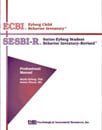
Eyberg Child Behavior Inventory & Sutter-Eyberg Student Behavior Inventory-Revised ecbisesbi-r
For: Measure conduct problems in children ages 2-16 years
Reading Level: Infant - Adolescent
Format: Paper-and-Pencil; Online (via PARiConnect)
Length: 5 minutes to administer; 5 minutes to score
Scoring: Hand Scored; Online
Online Forms, Reports, Kits & e-Manuals
Click to browse products
Printed Kits
Click to browse products
Printed Forms & Handscoring Materials
Test forms, response booklets and scoring reference manuals.
ECBI i-Admin/Score Report (price per use for 1 i-Admin and 1 Score Report) min order 25
ECBI online Score Report (each) min order 5
SESBI-R online Score Report (each) min order 5
SESBI-R online i-Admin (each) min order 5
ECBI-SESBI-R Introductory Kit
ECBI Test Sheets (25)
SESBI-R Test Sheets (25)
Author
Sheila Eyberg, PhD
Description
The ECBI and the SESBI-R are comprehensive, behaviourally specific rating scales that assess the current frequency and severity of disruptive behaviours in the home and school settings, as well as the extent to which parents and/or teachers find the behaviour troublesome. Both instruments consist of items that represent common behaviours in all children. The variety and frequency of these behaviours distinguishes normal behaviour problems from conduct-disordered behaviour in children and adolescents. The non-age-specific nature of the items also makes them widely generalisable. On both the 36-item ECBI and the 38-item SESBI-R, the parent or teacher indicates how often each behaviour currently occurs (7-point Intensity scale) and whether or not the behaviour is a problem (Yes/No Problem scale). ECBI and SESBI-R scores may be quickly and easily computed by hand in about 5 minutes each.
Test Materials
Test materials include the Professional Manual and the individual ECBI and SESBI-R Test Sheets. Completion of each rating sheet requires a 6th-grade reading level. Both instruments are also suitable for group administration or for administration via telephone.
The Professional Manual provides normative data and information on the psychometric strength of both instruments. The ECBI and the SESBI-R are reliable and valid instruments for efficient screening and tracking of disruptive behaviours in children and adolescents. The ECBI Intensity and Problem scales demonstrated high internal consistency, significant test-retest reliability, and significant inter-rater reliability, as well as convergent and discriminant validity. The newly developed SESBI-R Intensity and Problem scales demonstrated high internal consistency and significant test-retest reliability, as well as convergent, discriminant, and predictive validity. Both measures are sensitive to changes that may occur during treatment.
The section on interpretation includes case studies, as well as information about appropriate uses of the instruments for treatment screening and assessment of treatment outcome. Raw score-to-T-score conversions for the ECBI and SESBI-R Intensity and Problem scales for the total normative sample are provided in the appendix tables. A separate appendix lists various studies using the two instruments.
Using the ECBI and the SESBI-R
Used together, the ECBI and SESBI-R provide useful information for identifying and treating disruptive behaviour in children and adolescents, ages 2 through to 16 years. Each instrument provides a single set of non-age-specific items with a constant cut-off score across the ages from 2 to 16 years that facilitates longitudinal measurement of treatment progress and evaluation of the long-term effects of treatment. Because they measure both the frequency of each problem behaviour and the parent’s (or teacher’s) reaction to the child’s behaviour, they may provide additional insights into areas of the adult-child interaction that should be addressed.
NB: Prices are in Australian dollars inclusive of GST. NZ customers need to log in to view ex-GST prices.



